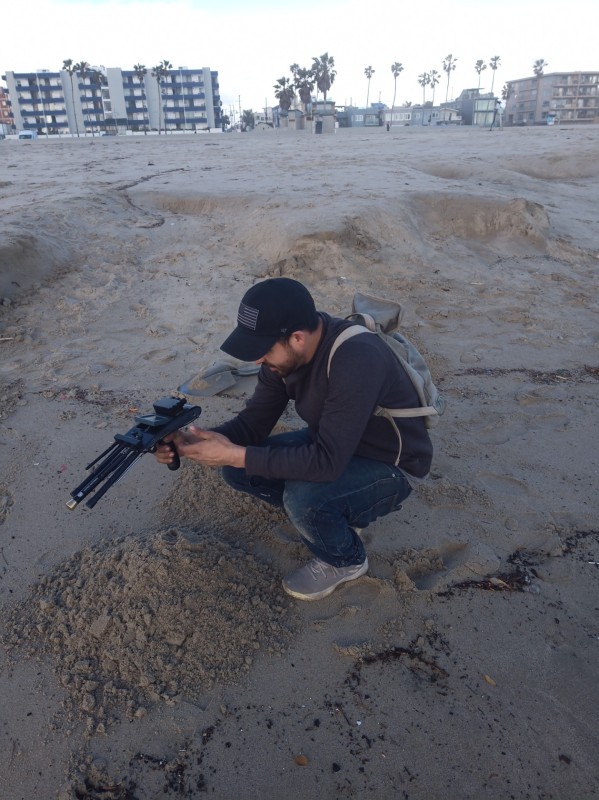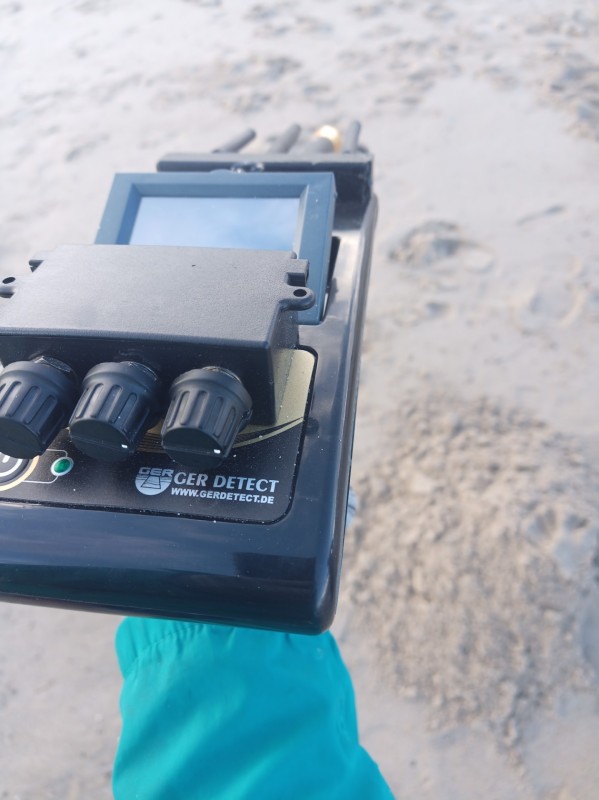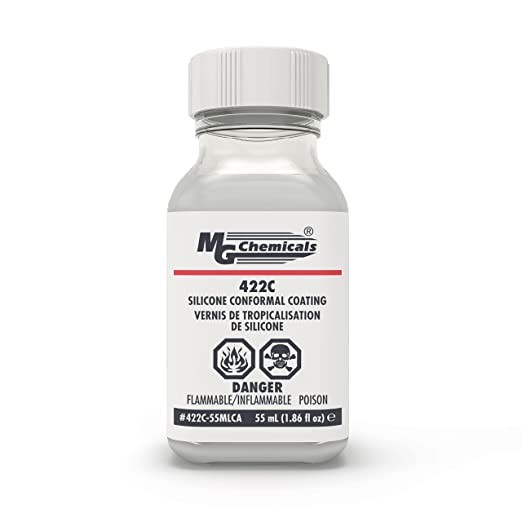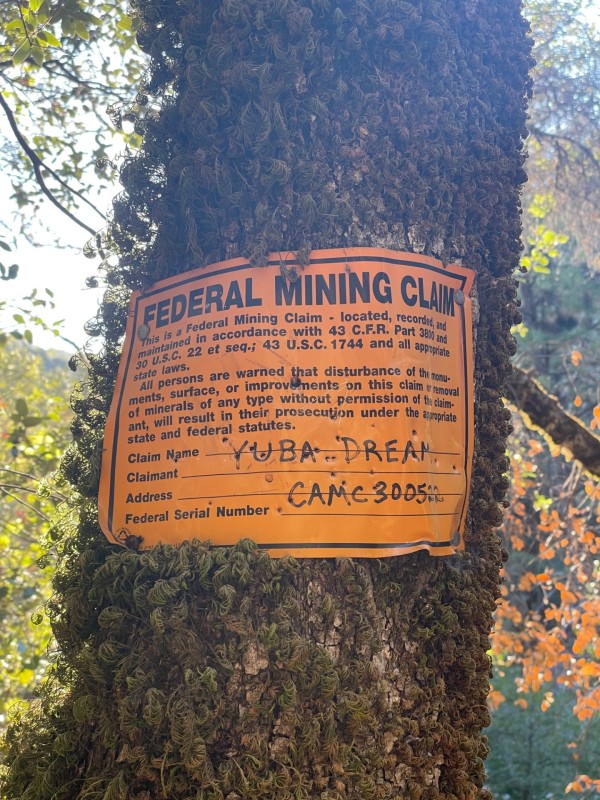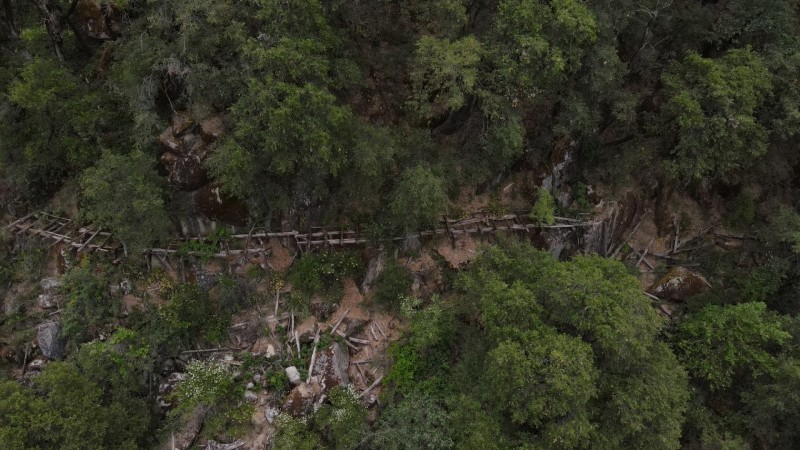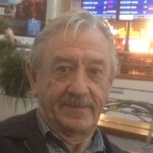Search the Community
Showing results for 'drone'.
-
Some mighty big nuggets in Russia. A drone would stand out a bit you'd think, good old fashioned car might have been easier.
-
That is a pretty sophisticated looking drone, good on those guys for thinking out of the box!
-
I have a wacky idea on the submarine topic - ULF frequencies used by subs and also emitted by certain natural phenomenon are known to travel a good distance through the earth itself and detectable inland like in Colorado and whatnot. Would there be a way to use those existing transmission already deep in the earth as "TX", and just use a lightweight "RX" handheld unit, or even a truck mounted loop? Obviously not for small nugget size targets, but maybe for larger conductive ore bodies for geophysical exploration? Similarly, would it be possible to build a massive "traditional" PI by running 4 stakes over like a 500ft diameter square, then winding a coil over the stakes and using that as a TX mono. Then using a lightweight RX handheld unit that senses the pulse timing for synchronization, use it to scan for really deep targets that are nugget sized? Or potentially a drone or atv mounted RX loop that might not need to be so close to the ground since the TX loop is so large? I'm curious to experiment with stuff like this that I've thought about for a while, but I just never have the time or resources to try.
-

I Determine How Much Ai Understands About Gold Detecting
jasong replied to jasong's topic in Detector Prospector Forum
These language based AI's are not good for that stuff. But clearly we have self driving cars, delivery robots, etc that can handle spatial coordinates and real time visual data. But those are specialized cases, not stuff easy for the public to access like ChatGPT, etc. The problem is anything wheeled runs into rocks, bushes, etc. Anything with a coil that needs to touch the ground runs into the same issue. And anything flying drone based cannot get a coil real close to the ground, plus it's own motors create a ton of noise that makes things like detectors hard to use. I have a few other solutions to larger scale, semi-automated prospecting. But it'd require a lot of tinkering/research/building/failures, and at this point in life I doubt I'll ever have the time to do it since the payoff isn't that great compared to other things I could spend time on. -
I'm looking into getting a quadcopter for photogrammetry, but have no experience with them at all. Are there specific features that are better than others? What kind of camera resolution is best, and are shutter speeds and drone stability usually good enough to capture good quality, usable photographs? I'm at the beginning of my research, so any tips and recommendations would be greatly appreciated. I saw some information about drones in this article: https://thedigitalcamera.net/best-drones-with-camera/, please tell me which is the best.
-
I Determine How Much Ai Understands About Gold Detecting
FarTraveller replied to jasong's topic in Detector Prospector Forum
How about a solar powered AI driven autonomous drone that drives around obstacles to scan every inch if a site to map every likely gold signal? -
A couple of days ago I was at one of my local beaches after the rain and blow. It had been a rather 'sudden' type of storm with waves only up for 24 hours or so. My results showed it and near the end of my detecting I noticed something odd. I looked up into the dry sand and I saw someone kneeling with a shovel. I was 100 yards away or so and I saw some movement and thought it strange. It reminded me of some type of ritual burial. I wanted to go up and tell the guy if he was burying ashes or something of value he should reconsider as some other detectorist would dig it up. A few minutes passed and it was time for me to go to my car. I wanted to go by the place where the guy was digging. When I got there it had been neatly filled and scattered over with some beach sticks. I thought good for him but then I saw him closer to the wet sand. He was digging another hole and I saw this motion again. It reminded me of a drone this time. A bit of black whirling around and then it hit me. I propped up my 800/15 and walked in his direction. He was a nice-looking young man and he greeted me as I approached. He had dug an almost smoothly round hole with a short handled shovel about 18" deep. I told him I had noticed what he was using and I just couldn't resist coming over to him. He had a thick European accent. He could see my detector which I had turned off about 50 yards away. He began asking me if there was little pieces of gold in the sand. He was rubbing his fingers together saying he was learning his instrument. I asked him if it was made in Germany and he said yes. It was then that I knew 'the gig' and I was careful not to venture to many comments. He was quite enthusiastic about his instrument explaining that he had bought it from a guy (friend?) that said it didn't work but he was convinced he was going to make it work. This was not the first one of these detectors I've seen but it was the first one that I've held. It is relatively small and it will rotate around on its handle so quickly it is a kind of like using divining rods. He showed me the little popup screen that I would have needed my glasses to read and it has several functions. One was to create a line similar to a surveying instrument. He explained that you needed to hold the contraption level and look off into the distance a couple of hundred feet. Then you needed to walk the line and reverse the process and it would create an intersection. That is where you needed to dig! My eyes are rolling up in my head at this point remembering the threads that have been started here about these things. I told him how I detected the beach with my Equinox and he just couldn't be bothered. He had faith in his instrument. He was in full blown pursuit of the truth. When I explained to him that my coil sometimes ran over multiple targets in a swing and sometimes there were targets above and below each other it just didn't register to him. The scale of delusion was massive. I could have spent more time with him and gotten his phone number and gradually shattered his dreams but I just didn't have the heart. I told him about the cost of the Equinox coming in around $1000 and it was then that he proudly said he paid $5500 for his gizmo. It was then I realized it was time for me to leave. I hope he has 'fun' with his experiments. This type of impractical 'science' makes me concerned for the world. I told him about Detector Prospector and actually hope he will make it here and find this thread. I have some other thoughts about the experience but I'll just leave them for now and post the two pictures I took.
-
Forget VLF and PI: here comes the BastardXWave! Fully utilizing the latest XWave technology the BastardXWave detector punches far deeper than any other detector ever invented in the long history of detector prospecting, both on land and sea (it’s submersible to -801 metres). With this detector there is absolutely no need to dig for anything except your favourite metals, coins, jewellery or relics. Its vastly superior XWave detecting technology ignores all crap, including bottle tops, aluminium foil, nails or lead sinkers/birdshot (and everything else you don’t want to dig). It’s as easy as flipping the dial to the ‘IGNORE ALL CRAP’ mode and the BastardXWave does the rest. In the IAC mode the user has a ‘Voice Assist’ option where a very seductive female voice suggests you dig a bit further to the left or right to hit the hot spot. Obviously, by dialling the ‘DIG ALL CRAP’ mode you’ll be digging crap all day long. Although any serious detector prospector will scoff at the DAC mode, it does keep newbies and kiddies entertained for days (if not weeks). Once you’ve flipped to the desired mode, you’ll need to tell the BastardXWave what it is you’re looking for. If you only want to find gold just push the ‘FIND GOLD YOU BASTARD’ button in the IAC mode. In the FGYB setting the BastardXWave will immediately find gold no matter how tiny or deep in the hottest ground, just wave the detector in the general direction of the area you want to search (you don’t even have to leave your car, just make sure you wind down the windows). You can rest assured that in the FGYB setting all you’ll be digging for is gold, in fact you’ll find so much of the yellow stuff that you’ll be able to pay someone else to do the digging for you. It’s the same for all other metals (such as silver, copper, lead or zinc), just hit the right button whilst in the IAC mode and become an instant billionaire! If you have the urge to find only alloys, just hit the ‘FIND ALLOYS YOU BASTARD’ button in the IAC mode and the BastardXWave will hone in on any alloy humankind and aliens have ever created. Here the ‘Voice Assist’ girl tells relic hunters whether they are digging for an ancient pewter goblet or a wrought iron spoon. In fact, the seductive voice easily identifies the age the relic was created, for example during the Victorian Age or even the Bronze or Iron Ages (if some hunter-gatherer smelted it, the BastardXWave will find it!). Besides analysing age and metal combinations, the detector also shows the condition and current market value of any relic it has spotted, this is of great value in deciding if your lackey digs or not. To find any coins of any country no matter how old just push the ‘FIND COINS YOU BASTARD’ button in the IAC mode and away you go. Just walk around any public place (parks, sporting grounds, beaches etc.) with the FCYB setting turned on and the BastardXWave will alert you to the nearest coins in the vicinity, no matter how deep or how salty or hot the ground. This handy feature means there is no need to swing the detector until it plays ‘We’re in the money’ (a very appropriate ditty by the ‘Gold Diggers'). Likewise, simply pushing the ‘FIND JEWELRY YOU BASTARD’ button does the same thing for any piece of jewellery you can think of. In the FJYB setting the detector will play George Jones and Tammy Wynette’s ‘Golden Ring’ before you need to start swinging. The BastardXWave is also extremely sensitive to diamonds and other high-value gemstones; in the ‘FIND GEMS YOU BASTARD’ setting it’ll play Marilyn Monroe’s ‘Diamonds are a girl's best friend’ as soon as it shoots your latest stone-clad crown. Finding rare earth metals (including cerium, dysprosium, erbium, europium, gadolinium, holmium, lanthanum, lutetium, neodymium, praseodymium, promethium, samarium, scandium, terbium, thulium, ytterbium or yttrium) is also simplicity itself. Just flip the dial to IAC mode and hit the ‘FIND RARE EARTHS YOU BASTARD’ button. This will promptly find all of the rare earth metal thus far discovered (and even those that haven’t) down to extreme depths very close to the Earth’s core (some might be a bit too deep to dig). As with all the other settings, the FREYB setting can be tuned to the maximum depth you feel like digging; for example, your average detector prospector will be very happy with the 1-5 metres range whilst global mining companies use the BastardXWave to find tiny deposits of rare earth metals several kilometres deep. Likewise, finding meteorites of any size or composition is as easy as pushing the ‘FIND METEORITES YOU BASTARD’ button whilst in the IAC mode. This will instantly link the detector to satellites which beam down the latest lat/long coordinates of impact zones near you and pinpoint the nearest fragments. The BastardXWave also accurately predicts where and when the next meteorite strike will occur; another very handy feature which besides finding meteorites also allows you to take cover at just the right time. The BastardXWave’s manufacturer is currently working on ‘ERADICATE POVERTY’ and ‘STOP CLIMATE CHANGE’ settings. These awesome new settings will be available in latter models (including the BastardXWave Pro, BastardXWave Lite and BastardXWave Drone). Disclaimer: Due to deep fears of Chinese industrial espionage, the manufacturer will never release any photographs or technical information on how the BastardXWave works. None the less, you can still order one by privately contacting the manufacturer to haggle a fair price. The manufacturer will only sell the BastardXWaves on the condition that the buyer promises not to brag too much about how much money they’re making from this detector. Because the BastardXWave is so undeniably unique, the manufacturer regrets that there will be no refund after it’s been mailed to the buyer. Nor is there any form of warranty or spare parts. Just one left! Buy it now before it’s sold out!
-
I always utilise my detector in a boustrophedonic fashion. It's a scientific fact that boustrophedonically surveying the terrain is optimal. https://en.wikipedia.org/wiki/Boustrophedon The concept of metal-detecting with drones came up on another forum once ( Geotech1, likely ). I pointed out the XP Deus could probably be persuaded to operate at long range, if the 'remote' unit was modified to use a high-gain antenna ( parabolic dish / waveguide 'cantenna' / Yagi array), the hard bit was getting the drone to fly close to the ground but not too close.
-
I recently sent one of my White's detectors to Centreville Electronics for repair. It is a TDI BeachHunter which has a waterproof case but condensation built up in the control box during a hunt in the cold rain and surf this past month and it stopped working. I believe that if I had taken the time to waterproof the circuit board in my TDIBH that I could have avoided the failure of the detector despite the condensation problem. I have been reading up on PCB waterproofing and have found out that it seems to be a growing practice in many do-it-yourself hobby applications such as waterproofing drone controls for wet weather use. There are several specialized products available but even a simple coating of nail polish was mentioned in a number of articles as being a cost effective method. Has anyone here tried this? It seems like cheap enough insurance to minimize the risk of damage to a detector if it gets dropped in the water, splashed on, spilled on or rained on. I am considering using the product in the attached picture.
-
.thumb.jpg.8761b3d9b3da119b9e6d1912f67275ad.jpg)
Buckles And Bullets
F350Platinum replied to F350Platinum's topic in Metal Detecting For Coins & Relics
Always great to have you come down, sometimes I feel bad when the hunts aren't all that fruitful due to your long travel, but ya saved me from having to buy dinner 😀 Your insights and advice are valuable to me, and I'm glad you can put up with my wild postulates. 🤣 I was really sad that the 900 didn't get into gear, it looks and feels like a great detector. I hope you do get to the bottom of the issue. 👍 With power lines almost a half mile off and no cell towers in the area that was really strange, maybe it was a drone LiDar mapping the area? 🤣 Yesterday there were Ospreys and A-10s flying all over, I couldn't hear my targets sometimes. A local naval air base does their training over this area instead of their home state, fewer people to complain I guess. 🤔 -
Drone detecting?🤔 Think I saw something like that on Discovery Channel!! Maybe that was Lidar i'm thinking of!?😂👍👍
-
Man, the sense of freedom to be able to do something like that...amazing. I keep reading about some drone-type craft that some companies are trying to make into a reality for people to fly in. I try not get my hopes up though. I started looking around at cheaper old 1960's airplanes the last few years too but it's just really hard to land one anywhere I like to go. Heh I came back to post the same thing - sounds like he needs to get the EMI fix done. He kept thinking it was his camera but it didn't look like it to me.
-

Giant Coils Looking For Gold From The Sky
jasong replied to phrunt's topic in Detector Prospector Forum
Looks like a proton precession magnetometer? This is the type of device I was talking about a few posts back which can be made smaller and drone mounted. They can be built fairly easily as they are mostly just a PVC tube full of water with a coil around the tube. The hard part is the electronics and data acquisition part. They also don't need to be oriented specifically, so they are good for flying around (as long as you can isolate the noise from the engines/motors). -

Giant Coils Looking For Gold From The Sky
jasong replied to phrunt's topic in Detector Prospector Forum
They probably aren't prospecting at all. You can use AEM's (aeroelectromagnetic surveys) to determine soil/gravel composition in rivers for groundwater management and whatnot. It's a bit like a geophysical survey that measures sound refraction of various soil intervals in concept, though different entirely in reality. Basically the conductivity of various things like silt/clay differ greatly from pebbles, boulders. And as we as detectorists know - soil conductivity variations can definitely be detected with a coil, we just tend to call it ground noise. But one person's noise is another person's data. These things have ridiculous "theoretic" depth when you are just looking at larger scale characteristics - like hundreds or more feet deep. So, anyone who thinks metal detectors are stuck at 3ft max, you are wrong. It just depends what you are looking for and what data you find important, if you ignore coil-on-a-stick models (and little gold nuggets). It's also why I have a lot of hope for the future of automated, remote UAV based prospecting. Not for like dinking around all day for 1 grammers, but for larger scale occurences and geologic patterns favorable to bringing finer resolution instruments in later. This concept already exists, it's a whole field called remote sensing and includes things like this, all the way up to satellites investigating planetary geology from orbit. BTW - proton precession magnetometers are much easier to build and fly, if one just wants to look for magnetite concentrations or other magnetic anomalies. You can build one on a bench and mount one on a standard DJI type drone. -
There are a ton of Minelab patents that are now quite a few years old and surely some of them are going to work their way into a new GPZ, or maybe a new detector entirely. Offhand I remember some new ZVT type coil designs for increased sensitivity and greater EMI/ground immunity. The old, heavy coils might be a requirement of the 7000 circuit more than ZVT in specific, so I wouldn't necessarily assume all ZVT coils will always be as heavy as the 1st gens. Depth ID. I'm still hoping for this one. In some cases 90% of the trash is no deeper than 4-5" so even just rough depth discrim to avoid the shallow stuff would save me a ton of digging and time. I'll give up tiny surface dinks to save that time, and just not use depth discrim when I'm dink hunting. This is and has been close to the top of my request list since making such lists for the 7000 prior to it's release. I'd almost prefer it over target ID/target discrim but I'd definitely take both. Hybrid machine. By recall there was something resembling a hybrid between either a PI and VLF or hybrid between ZVT and PI. Or both? I can't remember now. That would give you the ability to run a heavier DOD for patches, and a lighter mono for prospecting. Potentially also target ID/discrim if you could press a button and switch into VLF mode for IDs. A number of new signal processing algorithms for EMI and ground noise reduction. This is the most obvious way to increase performance - noise is the big target killer. I know I'm forgetting some other stuff I thought was pretty cool too. But off the top of my head this is the stuff that I haven't really seen in any other machines yet and so have to assume some of it is going into a new prospecting flagship. *Oh yeah: there was also that oddball patent about relating the location of the target to the coil in terms of XY coordinates, and then plotting the location of targets all onto a screen. Seems...eh, ho hum at first. But in the back of my mind I always hoped that was an indication of some kind of evolution from the coil-on-a-stick model to something automated (if just really low resolution) like a drone prospector or something. Now THAT is pie in the sky hot air imagination on my part, but hey, a guy can dream.
-
Yuba River Crevice Detecting For Gold Nuggets
Oleg replied to Smithsgold's topic in Detector Prospector Forum
-
Thanks for the paper! Thank you all of that post. There was so much in it. I'm new to everything to do with detecting so all of it was extremely helpful. What are your ideas on other methods of acquiring the signal? Is multi frequency analysis something that could be used? I was thinking an approach to this could be to use a similar approach to photogrammetry or biometrics. Only using image and no location data. The phone/drone/AR glasses would map key points of each image and an AI detects the location of the coil against the image. I'm doubtful if this could work right now, but I 100% think it will sometime in the future. In regards to you mentioning that induction is maxed out, are there any new alternatives? Maybe technologies that pick up so much that they're practically impossible to turn into a human interpretable audio signal, but could all be feed into some kind of neural network? Is multifrequency something in this direction?
-
To do this accurately you need to move away from GPS as it can only be accurate at best to within 6 feet. Fractions of an inch matter in coil coverage. I'm thinking a portable local solution. Perhaps consisting of laser tracking of a coil target monitored and recorded with precise positioning data coupled/integrated with visual information using a drone or drones hovering over the search area. Think golf ball flight tracking and virtual first down marker lines across the video display of a football field.
-
No, that is really easily sorted and works well right now. Tracking algorithms work well, also. I am sure AI could be applied but really you have a solution looking for a problem when it comes to ground tracking, to be frank. But I like your thoughts on drone mapping, etc. In the US, the USGS basically mapped out surface features using LIDAR that are proving to be very useful for prospecting and for revealing potential areas of archeological interest that for artifact and relic hunters. The problem to be solved is accurately tracking the coil as it is swung through the site. GPS does not cut it from a precision standpoint, but use of a stationary drone that is tracking and tracing the coil may be just the ticket. I think where AI and AR would be most useful as an adjunct to detecting is by mapping out ground coverage of the detectorists coil. Many detectorists just dig it all anyway and let their brains, eyes, and shovel be the actual discriminating intelligence. Depth is pretty much maxed out by the physical principle that forms the basis for metal detecting - Farday's law of induction. The targets that typically don't get recovered are either too deep (requiring another technology to be applied such as Ground Penetrating Radar) or are missed simply because the coil does not get passed over the target or gets passed over the target from the wrong approach angle. I have pondered a method by which a detectorist can see the ground he has covered by the detector coil in a particular detecting site simply by donning a pair of smart glasses that overlay the coil path across the ground that has just been detected. The detectorist can then improve his swing path coverage and also re-detect the "holes" in his coverage.
-
Hi BrokeInBendigo, Thank you for both such in depth posts. I'll do my best to try and summarize what I understand from them and then add/ask anything more. First it isn't very useful (potentially impossible) to detect between metals. It is far more useful to balance the ground and reduce EMI. Is this because EMI produces a lot of noise and leads to digging holes without any metal in? Or is it mostly distracting and mentally tiring over the hours? Secondly the ground conditions can vary enormously, essentially making a single model that knows everything impossible. Do the ground conditions vary hugely within one detecting session or is it more in different geographical areas? Something I hadn't considered was the scale of the area. I.e would a very experienced detector walk through a 5 kilometre square area and be able to narrow down a few 100 meter square areas that are worth detecting? If so, could AI be useful attached to a drone that scans a 2km area with various sensors attached, and then tries to narrow a few 100m areas to look in. As I write this I realise getting training data for this would be extremely hard. I really like the ideas around having a screen showing the raw waveforms. It seems from everyone's response that conditions can be so variable that the AI would have to be trained on each separate detection session. This presents a few challenges but could be possible. YouTube/Spotify etc all train customised AI models for each person. Right now it's possible to take about 30 photos of a bird vs not-bird on a hike, and train an AI in about two minutes on a standard laptop, with about 90% accuracy (not a hugely relevant example, but this was unthinkable 7 years ago). Of course no one wants to carry a laptop around, but there are AI specific training chips which are tiny. One on the iPhone as mentioned, but also more specialised ones like the Google Coral and Nvidia Jetson Nano. There is also the possibility of sending the waveforms over to servers to quickly train, but I imagine there isn't any 4G where everyone is detecting. Latest thought: There is a small AI training chip (no larger than a smartphone), with a screen (probably use smartphone app for it). The raw waves from the coil somehow connect into the chip. There are 3 buttons on the screen (label 1, label 2, train AI). When someone reaches the specific site they begin by choosing the labels. Maybe metal vs not-metal, but it could be anything depending what the detector thinks could work. As you dig holes you click which label it turned out to be. After say 30 holes you click 'train' and wait about 2 minutes. It then starts giving you a real-time prediction in a percentage of which label it thinks the coil is detecting. In no way does this replace the detector, you'd still use your usual method, there would just be something extra to test against. The approach of this method would be to have little AIs that are personalised to each persons local knowledge, and these AIs are each persons property unless they decide to share them. They may find that it works well distinguishing between two local features and they use it for that. Or that training after 10 samples is handy but they only trust the results about 40% of the time. Or that 500 samples is required, but that's okay because they regularly detect on similar ground. Or they upload and combine data with others in similar ground conditions. My last thought was that to collect data wouldn't it be possible to bury a few known items and scan over them in the specific soil? Or on a larger scale bury lots of samples in an area and scan over at different heights, add more soil above and scan again etc? To clarify how 30 samples could possibly work. We could use transfer learning on an AI trained on millions of images (called ImageNet), and then it is taught the new samples. Some people have had a lot of success turning waveforms into images and then training them with this AI. Thank you so much for the Dall E prompt booklet! I've got access to it so will definitely have a read through. Also are you in Bendigo, Victoria, Australia? I'm in Melbourne 🙂
-
Recently my wife and daughter gave me a drone for my birthday. Being a bit of a technical dinosaur, I am still getting the hang of it. These things seem to be rapidly advancing, and it occurred to me that it may provide a way of seeing what is over the next hill without all the footwork. Seeing how America seems to be leading the way with this technology, this seemed to be the ideal place to pose this Question. Any ideas?
-

My New GPX 6000 Is Faulty, Straight Out Of The Box
jasong replied to phrunt's topic in Minelab Metal Detectors
If you are a big fan of smooth thresholds then I suggest you give Auto+ with no threshold a try. It's not exactly "zero" threshold, technically speaking. Might take some getting used to if you are a threshold guy though. It's all I use with the 6000, and I detect in places that are EMI central fairly often. I have always sought to get the most stable, quietest threshold I could, while maximizing sensitivity as much as possible in those constraints. The perfect detector makes no noise on anything but targets to me - no ground, no EMI. The difference between full manual and Auto+ is minimal in sensitivity, and in some variable grounds I think it's actually better since Geosense is keeping things optimized. But the lack of like 75% of the normal EMI and background drone - sooooooo much better and easier to pick good targets. Auto+ with no threshold is basically like running the GPZ at a threshold of 5-10 with low smoothing on (incidentally the settings I posted/used on my GPZ and copped years of flack for). Except, there isn't nearly as much sensitivity hit as you would otherwise take running low smoothing on the GPZ. Best of both worlds IMO. I only use threshold for really detailed patch cleaning now - and at that point, I just use the GPZ instead anyways and the 8" or 17" CC X Coil. So, my 6 pretty much always stays in auto+ no threshold now. I carried both detectors with me everywhere for the first month I had my 6000. I no longer take my GPZ at all anymore though, unless I'm specifically trying to ward off the skunk detecting old patches, or working deep washes. It's because the performance compared to the 8" is so close, the extra depth from the 6000 on bigger (1+gram? untested) nuggets is useful, and the 6000 is so much quicker to use and so much lighter, that it just ends up being what I reach for out of sheer convenience. That's why I was saying a while back that the concentric is the only reason I still keep my GPZ (and the 8" for salt). I'm curious if you end up finding the same thing. Glad you can see the EMI/speaker problem yourself now so someone outside the US can vouch for the issue now too. It absolutely has everything to do with where you are located and how much EMI is in the air. And people that insist it doesn't exist are either not paying attention or in places that have very little EMI to deal with. I've been posting this since the 6000 came out, since I travel quite a bit and detect many different places I noticed the pattern quickly. I think I have a good idea why it does it and why the speaker affects it, I outlined in another post. I can't prove it, but I am familiar enough with MCU's and similar processors (FPGA or whatever they are using for Fourier analysis) that I just "feel" the 6000 occasionally does too much and confuses itself, gets overwhelmed, or glitches/bogs. I can't explain it, but it's the same feeling I get when I just know something is wrong with my truck because I'm so used to it even though I don't design trucks. -
Nugget Hunting Nevada With Steve And Steve
phrunt replied to abenson's topic in Detector Prospector Forum
Great work on the nuggets, and on the video, it was nice to tag along. Looks like you possibly got a couple more with the 6000 than the 5000 would have got you, only problem is now you'll want one 🙂 It's interesting ground there, until you go up in the air with the drone it could be mistaken for around here quite easily, the only difference being it is a lot flatter there which you notice far more when you go into the aerial shots. The gravelly ground, soil colour and plant life look similar to me. And Steve coming up with the big one! Gotta be happy with that. You all did very well. The title of your thread reminded me of when I first moved to NZ, everyone was called Dave. We had a plumber out to do some work straight away when we arrived, his name was Dave, the plumber needed an electrician to come, his name was Dave. We then got a builder out to do some work, his name was Dave. We met our new neighbour, his name was Dave, it just kept going on and on 🙂 It was really funny, and still makes me laugh today. My wife thought everyone in NZ was called Dave.


